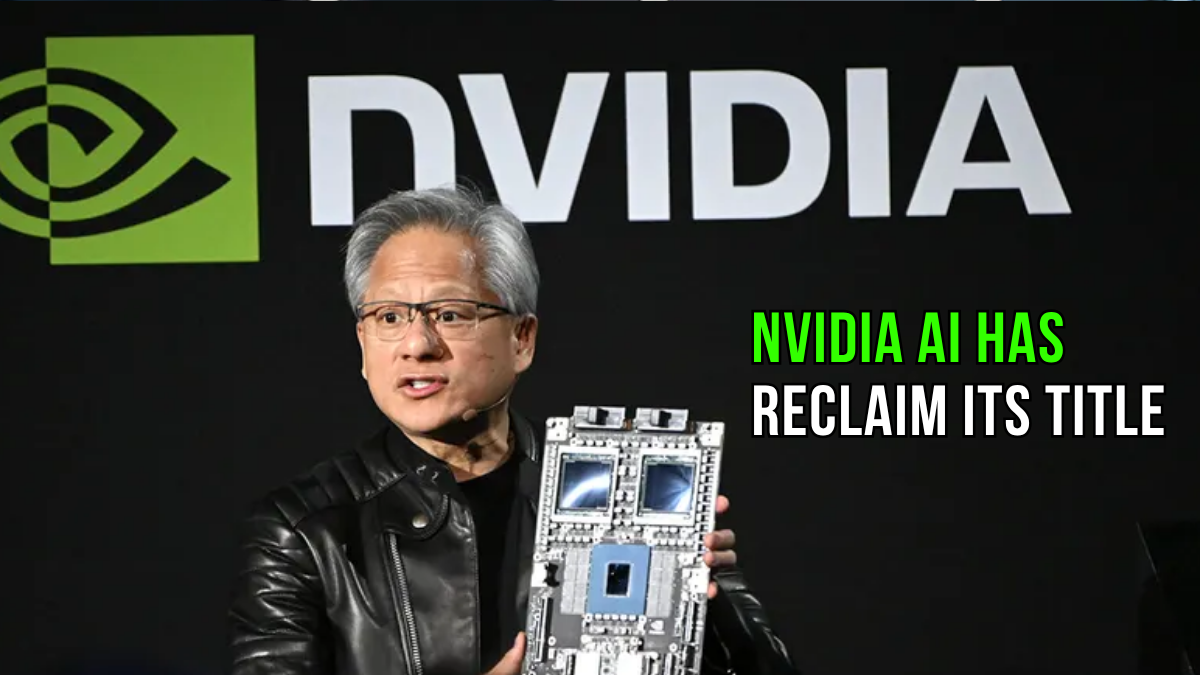Nvidia has officially reclaimed its position as the world’s most valuable company, with its stock soaring to record highs and pushing its market capitalization to an impressive $3.76 trillion. The chipmaker’s remarkable ascent signals more than just another milestone in the tech sector it represents a fundamental shift in how investors view artificial intelligence’s economic potential.

The latest surge comes after Loop Capital raised its price target for Nvidia to $250 from $175, maintaining its “buy” rating while predicting what analysts call the next “Golden Wave” of AI adoption. This bullish outlook reflects growing confidence that artificial intelligence is moving beyond experimental phases into widespread commercial deployment.
The Numbers Behind the Surge
Nvidia’s stock jumped over 4% to reach a record high of $154.10, allowing the Santa Clara-based company to overtake Microsoft, which held a market value of $3.65 trillion. This achievement caps a remarkable recovery for Nvidia, which has rebounded over 60% from its closing low on April 4.
The company’s valuation tells an interesting story about investor expectations. Despite the substantial stock gains, Nvidia currently trades at about 30 times analysts’ expected earnings for the next 12 months. This figure sits below its five-year average of approximately 40 times, suggesting that earnings estimates have been rising faster than the stock price itself.
This relatively conservative price-to-earnings ratio indicates that Wall Street’s optimism stems from genuine business fundamentals rather than speculative enthusiasm. Analysts have been consistently raising their forecasts as Nvidia continues to deliver stronger-than-expected results, creating a solid foundation for the company’s elevated valuation.
A Rotating Crown Among Tech Giants
The battle for the world’s most valuable company has become a three-way race between Nvidia, Microsoft, and Apple. These tech giants have traded positions several times over the past year, reflecting the dynamic nature of the technology sector and investors’ shifting priorities.
Microsoft had recently pulled ahead of Nvidia in early June, but the AI chipmaker’s latest surge has restored its position at the top. Apple’s stock rose 0.4% during the same trading session, maintaining its market value at approximately $3.0 trillion but remaining in third place among the tech titans.
This rotation demonstrates how quickly investor sentiment can shift based on company performance, market conditions, and technological developments. Each company brings unique strengths to the table: Apple’s consumer ecosystem, Microsoft’s enterprise dominance, and Nvidia’s AI infrastructure leadership.
The “Golden Wave” Prediction
Loop Capital’s prediction of a “Golden Wave” of AI adoption has captured investor attention and contributed significantly to Nvidia’s recent rally. According to analyst Ananda Baruah, “We are entering the next ‘Golden Wave’ of Gen AI adoption and Nvidia is at the front-end of another material leg of stronger than anticipated demand.”
This forecast suggests that the current wave of AI implementation is just the beginning. As businesses across industries recognize AI’s potential to transform operations, drive efficiency, and create new revenue streams, demand for the underlying infrastructure particularly Nvidia’s high-performance chips is expected to accelerate.
The “Golden Wave” concept implies that AI adoption will move beyond early adopters and tech-forward companies to become mainstream across virtually every industry. This broader adoption would create sustained demand for AI chips, supporting Nvidia’s long-term growth prospects.
Expanding Market Opportunities
UBS analysts have provided additional support for Nvidia’s bullish outlook by highlighting the company’s expanding pipeline of AI infrastructure projects. The firm estimates that Nvidia has visibility into “tens of gigawatts” of AI infrastructure projects, representing a potential revenue opportunity of around $1 trillion over the next two to three years.
This massive opportunity could drive annual data center revenue to approximately $400 billion double current forecasts for 2026. Such growth would represent a fundamental expansion of Nvidia’s addressable market, moving beyond traditional gaming and graphics applications into the much larger enterprise and cloud computing sectors.
The scale of these projections reflects the infrastructure requirements for deploying AI at scale. Training large language models, running inference workloads, and supporting real-time AI applications all require substantial computing power, creating sustained demand for Nvidia’s products.
Diversification Strengthens the Foundation
Beyond its core AI business, Nvidia has demonstrated impressive diversification across multiple revenue streams. The company’s networking revenue increased 64% quarter-over-quarter to approximately $5 billion, largely driven by sales of NVLink-enabled rack-scale systems.
Gaming revenue also showed robust recovery, rising nearly 50% from the prior quarter. Importantly, this growth was driven primarily by gamers rather than AI-related demand, suggesting healthy diversification across Nvidia’s business segments.
This diversification provides important stability for Nvidia’s business model. While AI infrastructure represents the primary growth driver, the company’s ability to generate revenue from multiple sources reduces dependence on any single market segment and provides resilience against potential downturns in specific areas.
Recovery from Recent Challenges
Nvidia’s current success becomes even more remarkable when viewed against recent challenges. The stock has rebounded over 60% from its closing low on April 4, when Wall Street was reeling from President Donald Trump’s global tariff announcements.
The recovery has been driven by expectations that the White House will reach trade deals to soften potential tariffs, along with growing confidence in AI’s long-term prospects. This resilience demonstrates investors’ faith in Nvidia’s fundamental business strength despite external uncertainties.
The company’s ability to navigate geopolitical challenges while maintaining its technological leadership position has strengthened investor confidence. This resilience suggests that Nvidia’s competitive advantages extend beyond purely technical capabilities to include strategic positioning and market relationships.
Broader Market Implications
The resurgence of AI-focused stocks has lifted the entire technology sector. The S&P 500 technology sector index reached an all-time high, gaining 0.9% and posting nearly 6% growth in 2025 alone.
This broader rally suggests that investor appetite for AI-related investments remains strong, despite periodic volatility. The sector’s performance indicates that the market views artificial intelligence as a transformative force with significant long-term potential.
The technology sector’s strength has implications beyond individual stock performance. It reflects a broader economic shift toward digital transformation, automation, and AI-driven innovation across industries.
Competitive Landscape and Market Position
Nvidia’s dominance in AI chips has created a significant competitive moat, but the company faces potential challenges from both established players and new entrants. Tech giants like Google, Amazon, and Apple are developing their own AI chips, while startups continue to emerge with innovative approaches to AI processing.
However, Nvidia’s current lead in both hardware and software solutions for AI applications provides substantial advantages. The company’s CUDA platform has become the industry standard for AI development, creating strong ecosystem lock-in effects.
This ecosystem approach means that developers, researchers, and companies investing in AI infrastructure often choose Nvidia not just for hardware performance, but for the comprehensive software stack and development tools that come with it.
Investment Considerations and Risks
For investors considering Nvidia’s stock, several factors warrant careful attention. The company’s valuation, while reasonable by its historical standards, still reflects high expectations for future growth. Any slowdown in AI adoption or increased competition could impact the stock’s performance.
Additionally, Nvidia’s business is inherently cyclical, with demand for semiconductors subject to economic fluctuations. However, the structural shift toward AI applications may provide more stable long-term demand than traditional semiconductor cycles.
The company’s success depends heavily on continued AI adoption across industries and sustained demand for high-performance computing solutions. While current trends appear favorable, the pace of technological change means that competitive dynamics could shift rapidly.
Looking Forward: Sustainability and Growth
The key question for Nvidia’s future performance centers on the sustainability of its current growth trajectory. UBS analysts believe that investor concerns about growth sustainability should be eased by the company’s visibility into substantial AI infrastructure projects.
The company’s ability to execute on its AI vision while navigating competitive challenges will determine its long-term success. Nvidia’s track record of innovation and market leadership provides confidence, but the rapidly evolving nature of AI technology means continued investment in research and development will be crucial.
The transition from experimental AI applications to production deployments represents a significant opportunity for Nvidia. As more companies move AI projects from pilot phases to full-scale implementation, demand for AI infrastructure is expected to grow substantially.
The Road Ahead
Nvidia’s return to the top of the market capitalization rankings represents more than just a financial milestone. It reflects the growing recognition that artificial intelligence is reshaping industries and creating new economic opportunities at an unprecedented scale.
The company’s remarkable journey from graphics card manufacturer to AI infrastructure leader demonstrates how technological innovation can drive extraordinary value creation. As the AI revolution continues to unfold, Nvidia’s position at the center of this transformation provides unique advantages and opportunities.
Whether Nvidia can maintain its crown remains to be seen, but its current position reflects genuine business fundamentals rather than speculative enthusiasm. The company’s ability to capitalize on the expanding AI market while maintaining its technological leadership will determine its future success.
The broader implications of Nvidia’s success extend beyond individual stock performance to signal a fundamental shift in how businesses and investors view artificial intelligence’s economic potential. As AI moves from experimental technology to essential infrastructure, companies like Nvidia that provide the foundational capabilities for this transformation stand to benefit significantly.
FAQs About Nvidia AI title
Q1: Why has Nvidia become the world’s most valuable company?
A1: Nvidia’s position as a leader in artificial intelligence technologies, particularly through its advanced GPUs and computing platforms, has driven its stock to record highs. Investors and analysts are optimistic about Nvidia’s role in supporting the rapid adoption of AI across industries, fueling unprecedented growth.
Q2: What is driving the AI boom?
A2: The AI boom is fueled by advancements in machine learning, large-scale data processing, and the development of generative AI models. These technologies require significant computing power, which Nvidia’s hardware and software solutions are designed to provide.
Q3: How does Nvidia benefit from AI adoption?
A3: Nvidia benefits from AI adoption by supplying the necessary infrastructure, such as GPUs and AI platforms, to businesses and researchers. This has positioned the company as an essential player in the global AI ecosystem, enabling its exponential growth.
Q4: What is the “Golden Wave” of AI adoption?
A4: The “Golden Wave” refers to the widespread and rapid adoption of AI technologies predicted by analysts. This wave signifies a turning point where AI integrates deeply into every sector, creating enormous opportunities for companies like Nvidia that provide the backbone of AI innovations.
Click HERE For More
